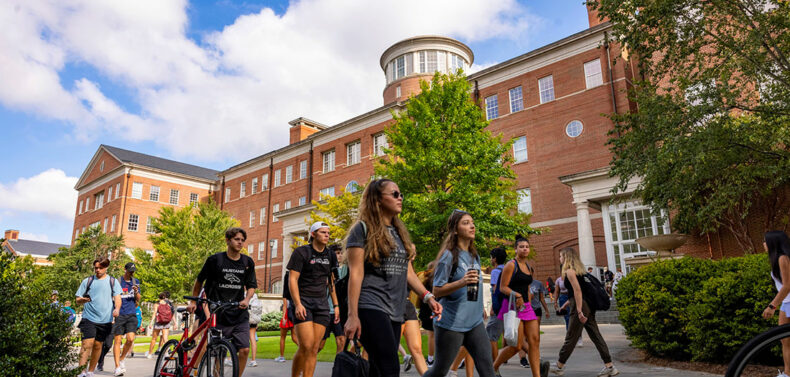The University of Georgia grew by 1,008 students this fall, according to the University System of Georgia’s semester enrollment report, bringing UGA enrollment to a new record of 41,615. That’s enough new students to nearly fill the big-box apartment complexes nearing completion at Finley and Broad streets. They’re bringing with them more money, jobs (mostly low-paying), vehicles, and upward pressure on real estate and rents.
UGA is poised for even more growth, with its second new freshman dorm in four years scheduled to open in the fall. UGA remains the state’s fourth-largest university, behind Georgia Tech (47,961, more than double 10 years ago) and Kennesaw State (45,152). Georgia State has been shrinking for five years, but for now remains the state’s largest university with 50,521 of the USG’s 344,392 students.
As in other parts of the country, flagship and urban universities like UGA, Kennesaw State and Tech have seen sharply rising enrollments in recent years, while many regional universities such as Valdosta State are coping with equally steep declines. Valdosta State’s fall 2023 enrollment, 10,180 students, is down 10% since 2019 and 20% since 2010. After years of such declining numbers, most of the USG’s regional universities and colleges added students last fall, however.
UGA enrollment has grown by about 7,079 students in the past decade, or about 20%. Beyond simple growth, demographic changes are reshaping both the UGA student body and its faculty.
One of the most striking trends is the recent drop in Black student numbers. In a state where almost a third of residents are Black, Black enrollment at UGA declined to 3,105 last fall, the lowest number since 2016 and, at 7.5%, the lowest percentage since 2008.
UGA’s Black enrollment peaked at 8.5% in 2017. Perhaps coincidentally, that was the year administrators angered many in the Black community by relocating likely enslaved individuals’ remains to a mass grave at Oconee Hill Cemetery after they were unearthed during construction at Baldwin Hall.
Black enrollment in graduate and professional programs has grown substantially over the past decade, but not enough to counter the big decline in Black undergraduate numbers. According to the USG, the number of UGA Black undergraduates this fall was 1,904, down from 2,283 in 2018. UGA’s near-record 2023 freshman class of 6,146 included just 338 Black students, down 28% since 2017.
Black college enrollment and the number of Black students applying to college have also been declining nationally and in Georgia, though not as steeply as at UGA. In Georgia’s public colleges, Black enrollment was about 25% in fall 2023, down from nearly 28% in 2014.
The percentage of white students at UGA continues its steady decline, but white students are still a large majority at UGA: 64%, a higher percentage than all but three other public state colleges. Milledgeville’s Georgia College and State University tops that list with a student body that’s 79% white. About 44% of students across the university system’s 26 colleges and universities are white.
Asian students have been the largest minority group at UGA for years and remain one of the fastest-growing, up 54% in 10 years to 4,935 students in 2023. The category includes students of Indian heritage, as well as those with roots in China, Japan and many other Asian countries.
UGA is also enrolling more out-of-state students. UGA’s record 6,986 out-of-state students this school year are about 17% of UGA enrollment, up from 12.6% in 2013. International students were an additional 5.6% of UGA’s fall 2023 enrollment, at a record 2,348. Together, international and out-of-state students account for nearly half of UGA’s enrollment growth since 2013. By contrast, about 40% of Georgia Tech’s 47,961 students are from other states, and 31% are from other countries, many of them studying online.
Women significantly outnumber men in the UGA student body, a decades-long and continuing shift at colleges nationwide. At UGA, 59% of students were female last fall.
USG statistics also show a UGA student body that’s more affluent than most and increasingly urban. In fall 2022, 17.2% of UGA students were receiving Pell Grants—a lower percent than in all but two other public schools, Georgia Tech and Georgia College and State University. More than half of UGA’s 2023 freshman class came from five metro Atlanta counties: Cobb, Forsyth, Gwinnett, Fulton and DeKalb.
University System data also shows a dramatically changed faculty demography in the first two decades of the 2000s, at least in terms of gender. In 2003, 27.6% of UGA’s faculty was female. By 2014, 38.9% of the faculty were women, but with little change since. Only two Georgia public colleges have a higher percent of male faculty than UGA: Georgia Tech and Savannah State University. In 15 of the state’s 26 public colleges and universities, women are now a majority of faculty.
Black faculty representation at UGA has hardly changed in 20 years, however. Just 100–or 5.3%—of UGA’s 1,873 faculty members were Black in 2022, the same percentage as in 2003. Just four University System schools list a smaller percentage of Black faculty than UGA: Georgia Tech, the University of North Georgia, South Georgia State College and Georgia Southwestern University in Americus, which reported exactly one Black faculty member in 2022.
Overall Black employment at UGA has also declined in the 2000s—1,305 Black workers in 2022, down from 1,399 in 2000.
Like what you just read? Support Flagpole by making a donation today. Every dollar you give helps fund our ongoing mission to provide Athens with quality, independent journalism.









